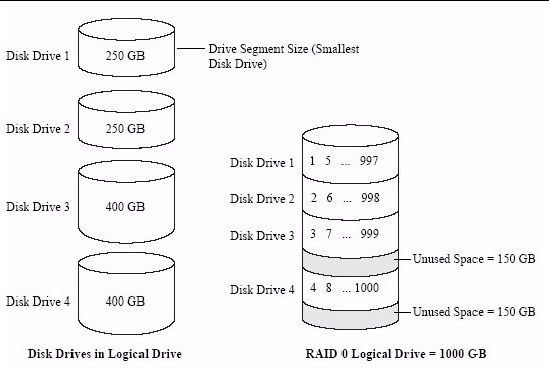RAID (Redundant Array of Independent Disks) is a method of combining multiple disk drives into one logical unit to provide data redundancy, performance improvement, or both. RAID 5 is a commonly used RAID level that provides data striping at the byte level as well as parity protection against the failure of one disk drive.
With a three-disk RAID 5 array consisting of 500 GB disks, the total raw capacity would be 1500 GB (3 x 500 GB). However, some of that capacity is used for parity information, so the actual usable space is less than the total raw capacity. Let’s calculate how much usable space is available in this RAID 5 setup.
RAID 5 Overview
In RAID 5, data is striped across all the disks in chunks of a certain size, just like in RAID 0. However, RAID 5 also reserves space equivalent to 1 disk’s worth of capacity for parity information that is distributed across all the disks.
The parity information is calculated based on the data on the other disks and can be used to reconstruct data in case of a single disk failure. Since parity info is spread over all disks, RAID 5 provides redundancy while avoiding the 2x overhead of mirroring (RAID 1).
RAID 5 Capacity Calculation
With N disks in a RAID 5 array, the total capacity is equal to:
Raw capacity = N * (disk size)
However, the usable capacity is less because of the parity disk overhead. The formula is:
Usable capacity = (N - 1) * (disk size)
So for a 3-disk RAID 5 array with 500 GB disks, the raw capacity is 1500 GB but the usable space is only 1000 GB due to 1 disk worth of capacity reserved for parity.
Step-by-Step Capacity Calculation
Let’s go through the RAID 5 capacity calculation step-by-step for our 3 x 500 GB disk example:
- The raw capacity is equal to the number of disks multiplied by the disk size:
- Since 1 disk worth of capacity is used for parity, the usable capacity is:
Raw capacity = 3 * 500 GB = 1500 GB
Usable capacity = (Number of disks - 1) * Disk size
= (3 - 1) * 500 GB
= 2 * 500 GB
= 1000 GB
Therefore, the total usable space provided by a 3-disk RAID 5 array of 500 GB disks is 1000 GB.
Usable Space Visualization
Here is a diagram to visualize how the RAID 5 usable space is calculated for the 3 x 500 GB disk configuration:
| Disk 1 | Disk 2 | Disk 3 |
|---|---|---|
| 500 GB (Data + Parity) |
500 GB (Data + Parity) |
500 GB (Data + Parity) |
Total Raw Capacity = Disk 1 + Disk 2 + Disk 3
= 500 GB + 500 GB + 500 GB
= 1500 GB
Usable Capacity = Disk 1 + Disk 2
= 500 GB + 500 GB
= 1000 GB
The table shows the capacity of each 500 GB drive. But since 1 disk worth of space is used for parity across all drives, the usable capacity is only the sum of 2 drives = 1000 GB.
RAID 5 Benefits
The key benefits of using RAID 5 with multiple disks include:
- Improved read performance compared to a single disk, due to load balancing reads across multiple disks.
- Tolerance against a single disk failure. If one disk fails, data can be rebuilt from the parity information.
- Efficient use of capacity – Only 1 disk worth of capacity reserved for parity, compared to RAID 1 mirroring where 50% of total space is used for redundancy.
RAID 5 provides a great balance of performance, redundancy and efficient use of storage capacity. The usable space calculations allow you to properly plan storage capacity requirements.
Factors Impacting Performance
While RAID 5 improves performance compared to a single disk, there are some factors that can impact its overall speed:
- The underlying disk speed – RAID is dependent on the speed of the actual drives used. Use faster drives like SSDs for better performance.
- The RAID controller – This controls how efficiently data is distributed across disks. An efficient controller minimizes bottlenecking.
- Type of workload – Certain access patterns like large sequential reads/writes work better than small random I/O.
Optimize these factors to get the most out of your RAID 5 array’s performance potential. Pay attention to disk speed, RAID controller caching algorithms, and matching your workload characteristics.
Alternative RAID Levels
While RAID 5 offers a good balance for many use cases, there are some other RAID levels that may be better suited depending on your specific needs:
RAID 0
- Block-level striping without parity or mirroring.
- Provides best performance but no redundancy.
- Good for temporary storage that needs speed but not fault tolerance.
RAID 1
- Disk mirroring between pairs of drives.
- Provides 100% redundancy but uses 50% of capacity for duplicates.
- Simple mirroring is easy to implement and can improve read performance.
RAID 6
- Block-level striping with double distributed parity.
- Protects against failure of 2 disks instead of just 1.
- Preferred for arrays with larger number of disks to minimize rebuild times.
Evaluate your specific requirements like performance, redundancy levels, and capacity to determine if an alternate RAID level may be more optimal.
Conclusion
To summarize, a 3-disk RAID 5 array with 500 GB drives provides the following usable capacity:
- Total raw capacity = 1500 GB (3 x 500 GB)
- RAID 5 usable capacity = 1000 GB
The usable space is less than the raw capacity because RAID 5 reserves 1 disk worth of space for parity information. Carefully account for this overhead when planning your usable storage with RAID 5. Optimizing factors like disk speed, controller efficiency, and matching the workload can help maximize the performance.

